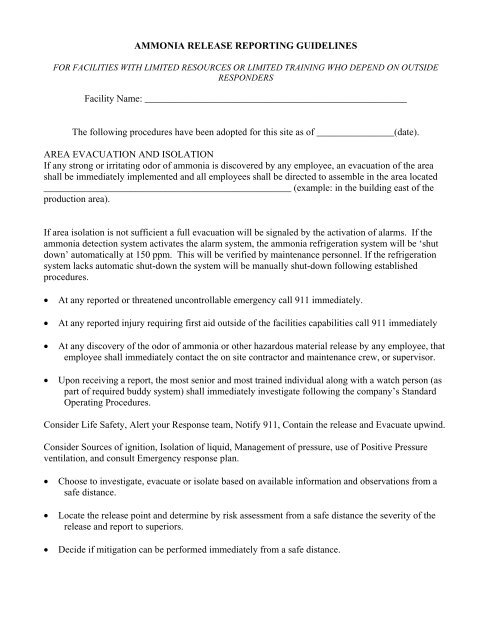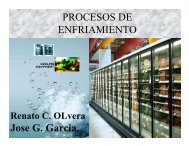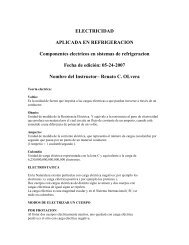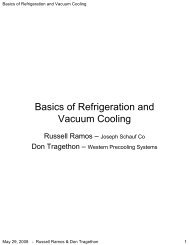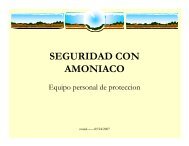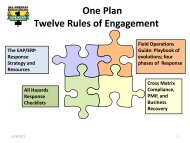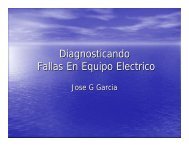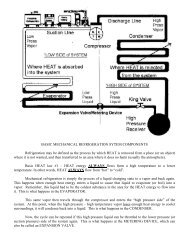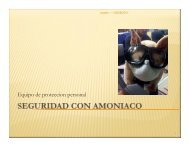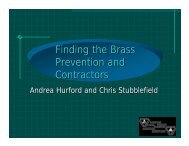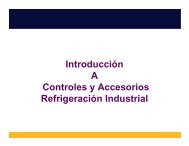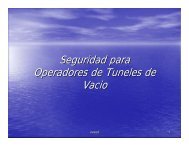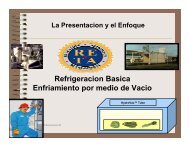AMMONIA RELEASE REPORTING GUIDELINES - Salinas Valley ...
AMMONIA RELEASE REPORTING GUIDELINES - Salinas Valley ...
AMMONIA RELEASE REPORTING GUIDELINES - Salinas Valley ...
You also want an ePaper? Increase the reach of your titles
YUMPU automatically turns print PDFs into web optimized ePapers that Google loves.
<strong>AMMONIA</strong> <strong>RELEASE</strong> <strong>REPORTING</strong> <strong>GUIDELINES</strong><br />
FOR FACILITIES WITH LIMITED RESOURCES OR LIMITED TRAINING WHO DEPEND ON OUTSIDE<br />
RESPONDERS<br />
Facility Name: ______________________________________________________<br />
The following procedures have been adopted for this site as of ________________(date).<br />
AREA EVACUATION AND ISOLATION<br />
If any strong or irritating odor of ammonia is discovered by any employee, an evacuation of the area<br />
shall be immediately implemented and all employees shall be directed to assemble in the area located<br />
___________________________________________________ (example: in the building east of the<br />
production area).<br />
If area isolation is not sufficient a full evacuation will be signaled by the activation of alarms. If the<br />
ammonia detection system activates the alarm system, the ammonia refrigeration system will be ‘shut<br />
down’ automatically at 150 ppm. This will be verified by maintenance personnel. If the refrigeration<br />
system lacks automatic shut-down the system will be manually shut-down following established<br />
procedures.<br />
• At any reported or threatened uncontrollable emergency call 911 immediately.<br />
• At any reported injury requiring first aid outside of the facilities capabilities call 911 immediately<br />
• At any discovery of the odor of ammonia or other hazardous material release by any employee, that<br />
employee shall immediately contact the on site contractor and maintenance crew, or supervisor.<br />
• Upon receiving a report, the most senior and most trained individual along with a watch person (as<br />
part of required buddy system) shall immediately investigate following the company’s Standard<br />
Operating Procedures.<br />
Consider Life Safety, Alert your Response team, Notify 911, Contain the release and Evacuate upwind.<br />
Consider Sources of ignition, Isolation of liquid, Management of pressure, use of Positive Pressure<br />
ventilation, and consult Emergency response plan.<br />
• Choose to investigate, evacuate or isolate based on available information and observations from a<br />
safe distance.<br />
• Locate the release point and determine by risk assessment from a safe distance the severity of the<br />
release and report to superiors.<br />
• Decide if mitigation can be performed immediately from a safe distance.
Mitigation Examples: First determine whether the release is coming from the high side or low side of<br />
the refrigeration system.<br />
• High Side: Immediately shut the ammonia system down by activating the nearest “emergency shutdown<br />
switch. Leave condensers on to reduce pressure.<br />
• Low Side: Immediately shut the ammonia distribution (feed) system down by closing the nearest<br />
liquid, king liquid and or hot gas valves. Allow the system to pump down the low side. Isolate<br />
point of release. Lower or raise system suction operating pressure at the leak point to zero or a<br />
couple inches of vacuum.<br />
<strong>REPORTING</strong> <strong>GUIDELINES</strong> AND DEFINITIONS<br />
“Immediately” is defined as soon as practicable after the report is received with 15 minutes given as a<br />
guideline. Reporting can’t hamper life safety or safely stopping the release.<br />
A non-threatening level of ammonia is defined by NIOSH as less than 25 ppm.<br />
Any employee that expresses discomfort at low levels of ammonia shall be allowed to leave the area<br />
until the area is clear of any residual ammonia. The employee shall be interviewed to determine if any<br />
injury is being reported and if so, the release reporting shall be implemented.<br />
Reporting is required where a significant release or threat of a significant release results or could result:<br />
1. In injury<br />
2. In damage to environmental or public receptors<br />
3. In any amount of ammonia leaving the property;<br />
4. In any amount of ammonia entering sewers or storm drains<br />
5. In significant interruption of facility activities exceeding area isolation or evacuation.<br />
NOTE: Any of the above 1-5 shall prompt reporting to the following agencies immediately (at least<br />
within 15 minutes).<br />
911 for emergency personnel<br />
Fire, Police, Hazmat, Coast Guard<br />
Monterey County CUPA 755-4511<br />
California OES 1-800-852-7550<br />
National Reporting Center 1-800-424-8802<br />
Cal OSHA (24 hour) 1-916-263-2800<br />
Neighboring Facility<br />
See neighboring facilities notification numbers attached.<br />
DISCLAIMER: This guidance is intended to serve as a reference for facility personnel in their<br />
development of facility reporting and emergency response policies and shall not replace or supercede<br />
guidance from the California Office of Emergency Services or pertinent laws and regulations.
<strong>AMMONIA</strong> <strong>RELEASE</strong> <strong>REPORTING</strong> <strong>GUIDELINES</strong><br />
FOR FACILITIES WITH LIMITED RESOURCES OR LIMITED TRAINING. WHO DEPEND ON<br />
OUTSIDE RESPONDERS<br />
IF TRAINED,<br />
QUALIFIED<br />
CONTRACTOR IS<br />
AVAILABLE ON SITE,<br />
REFER TO<br />
FLOWCHART<br />
FOR FACILITY WITH<br />
EXTENSIVE<br />
RESOURCES AND<br />
TRAINING<br />
NOTE:<br />
If the administering<br />
and responding<br />
agencies are familiar<br />
with the facility<br />
policies and personnel,<br />
downtime may be<br />
minimized.<br />
Small (Insignificant)<br />
Release<br />
IRRITATING ODOR OF<br />
<strong>AMMONIA</strong> PRESENT<br />
EVACUATE ROOM<br />
(All personnel who do not<br />
have the appropriate PPE<br />
or emergency response<br />
training)<br />
IF NO CONTRACTOR<br />
ON SITE, REPORT TO<br />
LOCAL CUPA<br />
DIAL 911<br />
Do not allow personnel<br />
back into the evacuated<br />
room(s) until approved by<br />
local CUPA or<br />
administering agency<br />
DOCUMENT<br />
APPROVAL FROM<br />
CUPA or administering<br />
agency:<br />
DOCUMENT<br />
RE-ENTRY ON<br />
FORM EPR-2<br />
NOTE: Applies to cold<br />
room or processing room<br />
where production or nonservice/maintenance<br />
employees are present.<br />
Disclaimer: This table is intended to comply with OES requirements as defined in the OES Booklet California Hazardous Material<br />
Spill/Release Notification Guidance and Monterey County Health Dept. interpretation. Defer to OES requirements if there is a discrepancy.
<strong>AMMONIA</strong> <strong>RELEASE</strong> <strong>REPORTING</strong> <strong>GUIDELINES</strong><br />
FOR FACILITIES WITH EXTENSIVE RESOURCES AND PERSONNEL TRAINING WHO WILL<br />
RESPOND THEMSELVES<br />
Small (Insignificant) Release<br />
IRRITATING ODOR OF<br />
<strong>AMMONIA</strong> PRESENT<br />
EVACUATE ROOM<br />
(All personnel who do not<br />
have the appropriate PPE or<br />
emergency response training)<br />
NOTE: Applies to cold room<br />
or processing room where<br />
production or nonservice/maintenance<br />
employees are present.<br />
MONITOR ROOM & DOCUMENT RESULTS USING:<br />
• Proper ammonia detector (hand held suitable for accurate measurements between 0-50 ppm, calibrated within time<br />
frame and using procedure recommended by manufacturer.<br />
• Personnel who have been trained on the specific ammonia detector (Include: sampling method, frequency and<br />
locations monitored)<br />
• Logging of: Time, Locations and PPM’s measured<br />
• PPE - Ammonia Safety Protective Gear or Level C (Example: APR, Air Purifying Respirator)<br />
IF LESS THAN 25 PPM <strong>AMMONIA</strong> IF GREATER THAN 25 PPM <strong>AMMONIA</strong><br />
EVACUATE AREA AND ISOLATE TO<br />
100 FEET MINIMUM FROM NON-<br />
REFRIGERATION PERSONNEL.<br />
CONTINUE MONITORING AND<br />
DOCUMENTING UNTIL SOURCE OF<br />
THE <strong>AMMONIA</strong> ODOR IS IDENTIFIED<br />
AND REPAIRED<br />
NO <strong>REPORTING</strong> REQUIRED Complete<br />
Internal Incident Report<br />
Learn from it!<br />
NOTE:<br />
If the administering and<br />
responding agencies are<br />
familiar with the facility<br />
policies and personnel,<br />
downtime may be<br />
minimized.<br />
EVACUATE ROOM (All personnel who do not have the<br />
appropriate Personal Protective Equipment (PPE) or<br />
emergency response training)<br />
REPORT TO LOCAL CUPA<br />
DIAL 911<br />
REPORT TO STATE OES: DIAL 1-800-852-7550<br />
IF OVER 100 LBS <strong>RELEASE</strong>D IN 24 HRS OR IF ANY<br />
SIGNIFICANT AMOUNT GOES OFFSITE REPORT TO<br />
NRC: DIAL 1-800-424-8802<br />
DOCUMENT APPROVAL<br />
FROM CUPA or<br />
administering agency:<br />
DOCUMENT<br />
RE-ENTRY ON<br />
FORM EPR-2<br />
Disclaimer: This table is intended to comply with OES requirements as defined in the OES Booklet California Hazardous Material Spill/Release Notification<br />
Guidance and Monterey County Health Dept. interpretation. Defer to OES requirements if there is a discrepancy.
<strong>AMMONIA</strong> <strong>RELEASE</strong> <strong>REPORTING</strong> <strong>GUIDELINES</strong><br />
FOR FACILITIES WITH EXTENSIVE RESOURCES AND PERSONNEL TRAINING WHO WILL<br />
RESPOND THEMSELVES<br />
Facility Name: ______________________________________________________<br />
The following procedures have been adopted for this site as of ________________(date).<br />
AREA EVACUATION AND ISOLATION<br />
If any strong or irritating odor of ammonia is discovered by any employee, an evacuation of the<br />
area shall be immediately implemented and all employees shall be directed to assemble in the<br />
area located ___________________________________________________ (example: in the<br />
building east of the production area).<br />
If area isolation is not sufficient a full evacuation will be signaled by the activation of alarms. If<br />
the ammonia detection system activates the alarm system, the ammonia refrigeration system will<br />
be ‘shut down’ automatically at 150 ppm. This will be verified by maintenance personnel. If the<br />
refrigeration system lacks automatic shut-down the system will be manually shut-down<br />
following established procedures.<br />
Consider Life Safety, Alert your Response team, Notify 911, Contain the release and Evacuate<br />
upwind.<br />
Consider Sources of ignition, Isolation of liquid, Management of pressure, use of Positive<br />
Pressure ventilation, and consult Emergency response plan.<br />
• At any reported or threatened uncontrollable emergency call 911 immediately.<br />
• At any reported injury requiring first aid outside of the facilities capabilities call 911<br />
immediately<br />
• At any discovery of the odor of ammonia or other hazardous material release by any<br />
employee, that employee shall immediately contact the on site contractor and maintenance<br />
crew, or supervisor.<br />
• Upon receiving a report, the most senior and most trained individual along with a watch<br />
person (as part of required buddy system) shall immediately investigate following the<br />
company’s Standard Operating Procedures.<br />
Consider Life Safety, Alert your Response team, Notify 911, Contain the release and Evacuate<br />
upwind.<br />
Consider Sources of ignition, Isolation of liquid, Management of pressure, use of Positive<br />
Pressure ventilation, and consult Emergency response plan.<br />
• Choose to investigate, evacuate or isolate based on available information and observations<br />
from a safe distance.<br />
• Locate the release point and determine by risk assessment from a safe distance the severity of<br />
the release and report to superiors.
• Decide if mitigation can be performed immediately from a safe distance.<br />
Mitigation Examples: First determine whether the release is coming from the high side or low<br />
side of the refrigeration system.<br />
• High Side: Immediately shut the ammonia system down by activating the nearest<br />
“emergency shut-down switch. Leave condensers on to reduce pressure.<br />
• Low Side: Immediately shut the ammonia distribution (feed) system down by closing the<br />
nearest liquid, king liquid and or hot gas valves. Allow the system to pump down the low<br />
side. Isolate point of release. Lower or raise system suction operating pressure at the leak<br />
point to zero or a couple inches of vacuum.<br />
Investigation and PPE (Personal Protective Equipment) Requirements<br />
Ammonia Concentrations Unknown<br />
To investigate release and monitor ammonia concentrations if there is no liquid ammonia splash<br />
potential - use Ammonia Safety Protective Gear or Level C PPE. Note that an Air Purifying<br />
Respirator (APR) with ammonia rated cartridges is required.<br />
Ammonia Concentrations 0-50 PPM<br />
To investigate release and monitor ammonia concentrations if there is no liquid ammonia splash<br />
potential - use Ammonia Safety Protective Gear or Level C PPE. Note that an Air Purifying<br />
Respirator (APR) with ammonia rated cartridges is required until areas have been monitored.<br />
Ammonia Concentrations 50 PPM-300PPM<br />
To investigate release and monitor ammonia concentrations if there is no liquid ammonia splash<br />
potential - use Ammonia Safety Protective Gear or Level C PPE. Note that an Air Purifying<br />
Respirator (APR) with ammonia rated cartridges is required.<br />
Evacuate and isolate area based on severity and exposures to a minimum distance of 100 ft.<br />
Monitor levels down wind. Down wind isolation distance will depend on ammonia<br />
concentrations.<br />
Ammonia Concentrations Greater Than 300 PPM - Do Not Enter.<br />
Level B or Level A PPE Required for Emergency Responders.<br />
Incident Command System Must Be Implemented Prior To Entry<br />
<strong>REPORTING</strong> <strong>GUIDELINES</strong> AND DEFINITIONS<br />
“Immediately” is defined as soon as practicable after the report is received with 15 minutes given<br />
as a guideline. Reporting can’t hamper life safety or safely stopping the release.<br />
A non-threatening level of ammonia is defined by NIOSH as less than 25 ppm.
Any employee that expresses discomfort at low levels of ammonia shall be allowed to leave the<br />
area until the area is clear of any residual of ammonia. The employee shall be interviewed to<br />
determine if any injury is being reported and if so, the release reporting shall be implemented.<br />
Reporting is required where a significant release or threat of a significant release results or could<br />
result:<br />
1. In injury<br />
2. In damage to environmental or public receptors<br />
3. In any amount of ammonia leaving the property;<br />
4. In any amount of ammonia entering sewers or storm drains<br />
5. In significant interruption of facility activities exceeding area isolation or evacuation.<br />
NOTE: Any of the above 1-5 shall prompt reporting to the following agencies immediately<br />
(at least within 15 minutes).<br />
911 for emergency personnel<br />
Fire, Police, Hazmat, Coast Guard<br />
Monterey County CUPA 755-4511<br />
California OES 1-800-852-7550<br />
National Reporting Center 1-800-424-8802<br />
Cal OSHA (24 hour) 1-916-263-2800<br />
Neighboring Facility<br />
See neighboring facilities notification numbers attached.<br />
DISCLAIMER: This guidance is intended to serve as a reference for facility personnel in their<br />
development of facility reporting and emergency response policies and shall not replace or<br />
supercede guidance from the California Office of Emergency Services or pertinent laws and<br />
regulations.
<strong>AMMONIA</strong> <strong>RELEASE</strong> <strong>REPORTING</strong> <strong>GUIDELINES</strong><br />
ALL FACILITIES<br />
Significant Release<br />
SIGNIFICANT<br />
<strong>AMMONIA</strong> <strong>RELEASE</strong><br />
EVACUATE ROOM OR AREA<br />
NOTE:<br />
Applies to all areas!<br />
(All personnel who do not have the appropriate PPE or emergency response training)<br />
NOTE:<br />
If the administering<br />
and responding<br />
agencies are familiar<br />
with the facility<br />
policies and personnel,<br />
downtime may be<br />
minimized.<br />
Activate Facility Emergency Response Plan.<br />
Consider Life Safety, Alert your Response<br />
team, Notify 911, Contain the release and<br />
Evacuate upwind or Shelter in Place.<br />
REPORT TO LOCAL CUPA<br />
DIAL 911<br />
REPORT TO STATE OES<br />
DIAL 1-800-852-7550<br />
IF OVER 100 LBS IS <strong>RELEASE</strong>D IN 24 HRS OR<br />
IF ANY SIGNIFICANT AMOUNT GOES<br />
OFFSITE REPORT TO NRC<br />
DIAL 1-800-424-8802)<br />
After release mitigated, in<br />
consultation with the Incident<br />
Commander and CUPA or<br />
administering agency, reenter<br />
evacuated areas.<br />
Document re-entry on Form<br />
EPR-2<br />
Disclaimer: This table is intended to comply with OES requirements as defined in the OES Booklet California Hazardous Material Spill/Release Notification<br />
Guidance and Monterey County Health Dept. interpretation. Defer to OES requirements if there is a discrepancy.
FORM: EPR-1<br />
EMERGENCY NOTIFICATION<br />
INFORMATION TO HAVE WHEN MAKING THE REPORT CALLS<br />
1. Your Name:<br />
2. Date:<br />
3. Company/Responsible Operation Name:<br />
4. Site Address:<br />
5. Duration of the release (not total time of incident but total spill time):<br />
6. Medium or Media: AIR WATER GROUND<br />
7. Number of injured (if any):<br />
8. Number hospitalized (if any):<br />
9. Number of persons evacuated from<br />
neighboring facilities or residences (if any)<br />
10. Estimate the quantity lost. From most equipment, relief valves are set at less than 60 Lb per minute<br />
of Ammonia (equivalent to 81 Lb per minute of Air) release rate). A rough estimate would be 1 Lb<br />
per second of ammonia released. (Field verify for greater accuracy)<br />
____________Seconds X 1 LB/Second = ________________ Lb Approximate Quantity Released.<br />
11. Do you have a completed Form EPR-2 in hand?<br />
MAKE THE FOLLOWING CALLS<br />
12. Document the name of person on the other end of the telephone line.<br />
• State Office of Emergency Services (OES) (1-800-852-7550)<br />
• Name: Date:<br />
Time Case #<br />
• Local Administering Agency (AA / CUPA) (831 755 4511 – Monterey County)<br />
Name: Date:<br />
Time Case #<br />
• National Response Center: (1-800-424-8802)<br />
Name: Date<br />
Time Case<br />
(Standard Form used with permission of WPS)<br />
DISCLAIMER: This form is intended to serve as a reference for facility personnel in their development of facility<br />
reporting policy
FORM: EPR-2<br />
EMERGENCY RESPONSE CHECKLIST<br />
Location of Leak: Date:<br />
Time of Day leak noticed: Time of day for end of incident:<br />
WEATHER CONDITIONS PRESENT DURING INCIDENT<br />
Temperature: Wind Direction: Speed:<br />
Humidity Fog? Rainy? Cloudy? Clear?<br />
1. Is everyone accounted for?<br />
2. Fire Department name and phone number – HazMat to dispatch from “911”<br />
a) Did you call the Fire Dept. for help? Y / N What time was the call ?<br />
3. Do you need police for traffic control? Y / N What time was the call ?<br />
4. Are there any injured ? Y / N How many ?<br />
5. Do the injured need more than on site first aid ? Y / N<br />
6. How did you transport them? Ambulance or Co-worker :<br />
7. Time of Transportation : _______________________ Destination:<br />
8. OSHA will need to be notified of any employee injury. Time of Call:<br />
9. Name of OSHA individual who took your call:<br />
10. Where any rooms (on-site) evacuated due to ammonia leak? (If Yes, complete below)<br />
Name of _____County Health Department person(s) who authorized re-entry:<br />
Date and Time of authorized re-entry:<br />
WHAT HAPPENED?<br />
(Standard Form used with permission of WPS)<br />
DISCLAIMER: This form is intended to serve as a reference for facility personnel in their development of facility<br />
reporting policy
Important Contacts:<br />
Specialists and hotline service here are a number of information specialists and hotline services<br />
available to provide information on hazardous substances. Examples include:<br />
• National Response Center (U.S. Coast Guard). This 24-hour service can give information on all<br />
aspects of release management. The law requires that employers notify the NRC for many<br />
releases. The telephone number is 800-424-8802.<br />
• Agency for Toxic Substances Disease Registry (ATSDR). This 24-hourservice will assemble an<br />
expert team of toxicologists and response experts and will come on site if needed. The telephone<br />
number is 888-422-8737.<br />
• CHEM-TEL Inc. - This 24-hour service will provide information on products as provided in<br />
manufacturers' MSDSs. The telephone number is 800-255-3924.<br />
• CHEMTREC - This 24-hour service will provide information on products as provided in<br />
manufacturers' MSDSs. It can assist in identifying and contacting a manufacturer of a product or<br />
shipment. The telephone number is 800-424-9300 or 703-527-3887.<br />
• National Pesticide Information Center. This 9:30 a.m. to 7:30 p.m. Eastern Time service will<br />
provide information on pesticides. The telephone number is 800-858-7378.<br />
• Rapid Response Information System (RRIS). This 24-hour service can be used as a reference<br />
guide, training aid, and an overall planning and training resource for response to a chemical,<br />
biological, and/or nuclear terrorist incident.<br />
• Regional Poison Control Centers (state-wide resources). This 24-hour service can provide<br />
information on the health risks associated with chemicals. It may have information on other<br />
hazards and appropriate responses. See the local telephone book for telephone numbers.<br />
• Manufacturer, importer, or distributor. The manufacturer, importer, or distributor of a hazardous<br />
substance may have a 24-hour hotline. Look for this telephone number on the MSDS or label.<br />
• Local Police, Fire, Medical, Hazmat, and Coast Guard 911<br />
• Monterey County CUPA 831-755-4511<br />
• California OES 1-800-862-7550<br />
• Cal OSHA (24 hour) 1-916-263-2800


